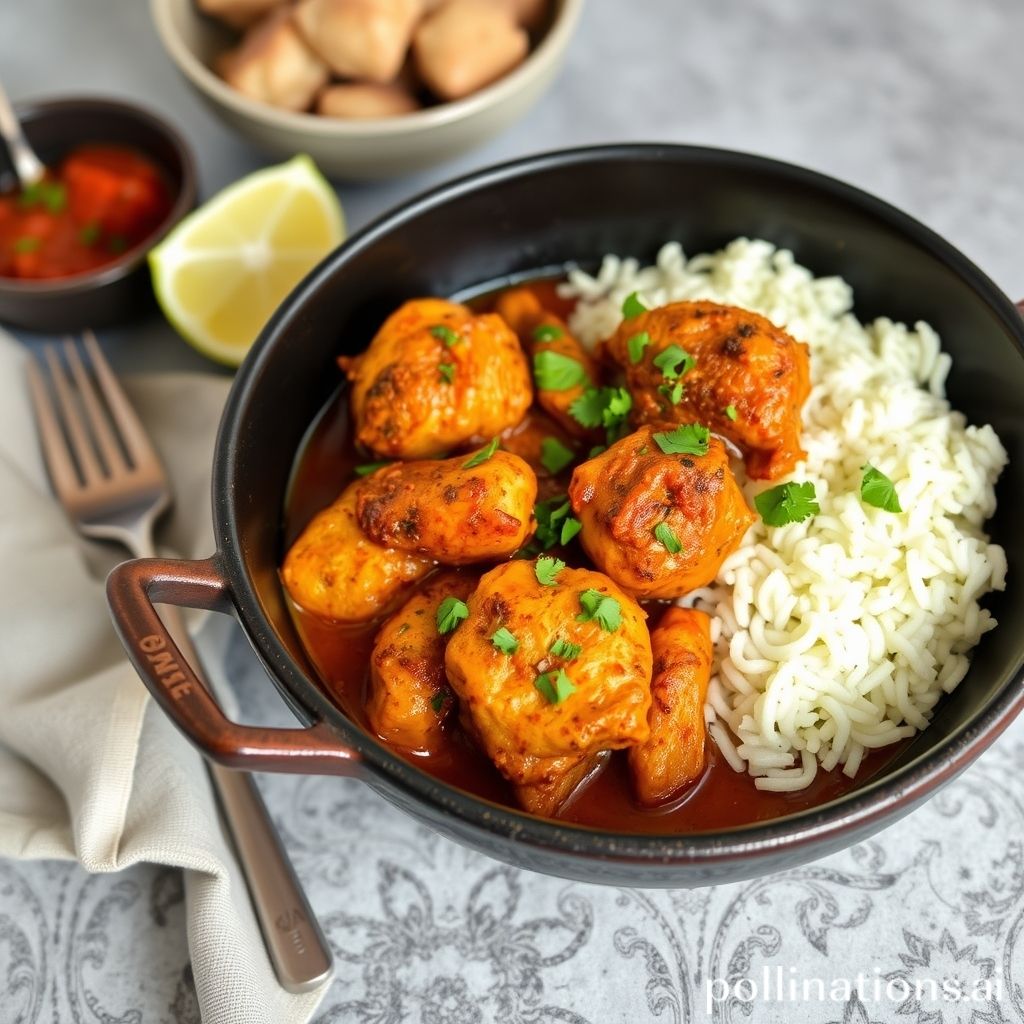Table of Contents
- Introduction
- The cultural significance of Moroccan Spiced Chicken Tagine
- Key ingredients and their roles in flavor development
- Traditional cooking methods and techniques
- Pairing and serving suggestions
- Health benefits of Moroccan spices
- Popular variations of the dish
- Tips for perfecting Moroccan Spiced Chicken Tagine
- Exploring regional differences in tagine recipes
- Conclusion
- Frequently Asked Questions
Introduction
Imagine a savory aroma wafting through your kitchen, a bold fusion of spices that transports you straight to the bustling markets and colorful alleyways of Morocco. Welcome to the art of creating a spiced chicken tagine, where tradition meets tantalizing taste buds.
In this culinary adventure, uncover the secrets behind the iconic Moroccan tagine, a feast for the senses that beautifully combines succulent chicken, fragrant spices, and the slow-cooked magic of a tagine pot.
Prepare to embark on a journey through a rich tapestry of flavors and textures, discovering how earthy cumin, smoky paprika, and vibrant saffron come together to create a dish that’s both comforting and exotic.
The cultural significance of Moroccan Spiced Chicken Tagine
Moroccan Spiced Chicken Tagine is a dish that holds deep cultural significance in Morocco, reflecting the rich history and diverse influences that have shaped Moroccan cuisine over the centuries. Originating from the Berber culinary tradition, the tagine is named after the specially designed earthenware pot in which it is cooked. This cooking method allows the ingredients to slowly simmer and combine, resulting in a flavorful and aromatic dish.
The diversity of spices used in Chicken Tagine, such as saffron, cumin, turmeric, and cinnamon, showcases Morocco’s historic role as a hub in the ancient spice trade routes. These spices not only add depth and warmth to the dish but also represent a blend of Arab, Berber, Moorish, and French influences, highlighting the cultural crossroads that Morocco occupies.
In Moroccan households, preparing a Chicken Tagine is often a communal activity, bringing families together to share in culinary traditions passed down through generations. This dish is typically enjoyed during special gatherings and celebrations, symbolizing hospitality, generosity, and community. By savoring Moroccan Spiced Chicken Tagine, one gains insight into the cultural heritage and social fabric of Morocco, making it far more than just a meal, but rather a cherished tradition.
Key ingredients and their roles in flavor development
The rich and aromatic flavors of Moroccan Spiced Chicken Tagine are achieved through a careful blend of key ingredients that contribute unique characteristics to the dish. At the heart of this culinary masterpiece is a myriad of spices, with cumin, coriander, and turmeric standing out. These spices not only add depth and warmth but also provide a distinct earthy and slightly pungent aroma.
Garlic and ginger are fundamental in building the savory base, offering a pungent kick that enhances the complexity of the tagine. Onion, often caramelized, contributes sweetness and a nuanced layer of flavor that rounds out the dish.
Another essential element is preserved lemon, which infuses the tagine with a tangy brightness and a subtle citrus note; this contrasts beautifully with the sweet undertones of dried fruits like apricots or raisins often included in the recipe. The sweetness is further balanced by the savory satisfaction provided by olives, which add a briny twist.
The harmony of these ingredients is achieved through the slow cooking process typical of tagines, where flavors meld together to create a symphony of taste that is both exotic and familiar.
Traditional cooking methods and techniques
Traditional cooking methods and techniques are fundamental to creating an authentic Moroccan Spiced Chicken Tagine. The word ‘tagine’ refers not only to the dish itself but also to the earthenware pot in which it is cooked, featuring a uniquely shaped conical lid that encourages the slow evaporation of juices, preserving moisture and taste. One of the key elements of this traditional cooking technique is the use of low, indirect heat, which allows the chicken to become tender while absorbing the intricate blend of spices typical of Moroccan cuisine. The spices, such as cumin, coriander, cinnamon, and saffron, are gently infused into the dish, creating a rich, aromatic flavor profile.
Traditional tagine cooking is often done over a charcoal brazier or an open flame, contributing to the dish’s deep, smoky flavor. This slow-cooking method allows time for the ingredients to marry, ensuring each bite is bursting with flavor. Additionally, traditional Moroccan cooks might opt for marinating the chicken in spices and herbs prior to slow-cooking, which further enhances the depth and complexity of the dish. Whether cooked in a conventional kitchen or by utilizing a traditional tagine pot, the emphasis on slow cooking remains the cornerstone of creating this timeless culinary masterpiece.
Pairing and serving suggestions
When serving Moroccan Spiced Chicken Tagine, it’s essential to enhance the flavors with well-chosen accompaniments. Traditionally, this savory dish is paired with fluffy couscous, which beautifully absorbs the rich, aromatic sauce. Rice is another excellent option for those who prefer a different texture. For a more authentic experience, consider serving it with warm, crusty bread. This allows you to scoop up every drop of the delectable sauce.
To balance the rich flavors of the Chicken Tagine, serve it alongside a fresh, crisp salad. A simple salad with mixed greens, cucumbers, and a lemon vinaigrette adds a refreshing contrast to the spices.
Drinks also play a vital role in a harmonious meal. A chilled glass of mint tea complements the earthy spices and provides a refreshing finish. If you prefer wine, a light, fruity white wine or a medium-bodied red wine can enhance the dining experience.
For those looking to add more elements of Moroccan cuisine, serving a side of roasted or steamed vegetables seasoned with a hint of cumin or turmeric can broaden the taste palette, making the meal both satisfying and memorable.
Health benefits of Moroccan spices
Moroccan spices are not only known for their vibrant flavors but also for their impressive health benefits. A key component in Moroccan cuisine, these spices are packed with antioxidants and essential nutrients. For instance, turmeric, a common spice in Moroccan dishes, contains curcumin, which is known for its powerful anti-inflammatory and antioxidant properties. Consuming turmeric may improve heart health and support joint function.
Cinnamon, another staple in Moroccan spice blends, can aid in regulating blood sugar levels, making it beneficial for those managing diabetes. Additionally, cinnamon has been linked to improved digestive health and possesses anti-microbial properties, which help fight bacterial and fungal infections.
Ginger, frequently used in Moroccan cooking, is renowned for its ability to alleviate gastrointestinal discomfort and nausea. It also contributes to reducing muscle pain and soreness due to its anti-inflammatory effects.
Paprika, rich in vitamins A and E, supports healthy vision and skin while providing a boost to the immune system. Cumin, known for its iron content, is essential for energy production and immune function. The incorporation of these spices in Moroccan dishes not only enhances the flavor but also offers a natural, healthy way to promote overall well-being.
Popular variations of the dish
Moroccan spiced chicken tagine is a versatile dish, with popular variations that reflect the diverse culinary traditions of Morocco. At its core, this dish is characterized by its use of aromatic spices like cumin, coriander, turmeric, and cinnamon, combined with tender chicken and slow-cooked to perfection in a traditional clay pot known as a tagine.
One well-loved variation incorporates dried fruits such as apricots or raisins, adding a delightful sweetness that balances the savory spices. Other recipes might include preserved lemons and olives, lending a tangy and slightly bitter note to the mix. Vegetables such as carrots, zucchini, and tomatoes are often added to enhance the flavor and nutritional value.
Different regions of Morocco may have their own takes on the chicken tagine. For instance, the coastal cities sometimes include seafood along with the chicken to reflect the bounty of the sea. In some areas, a liberal use of spicy harissa is favored for an extra kick.
These variations showcase the adaptability of the tagine to local tastes and ingredients, making it a beloved dish not just in Morocco but among food lovers worldwide.
Tips for perfecting Moroccan Spiced Chicken Tagine
Mastering Moroccan Spiced Chicken Tagine involves a few key tips to enhance its depth and flavor. Start by investing in traditional Moroccan spices like cumin, coriander, turmeric, and cinnamon for authenticity. A tagine pot, while not essential, helps in achieving the authentic, slow-cooked effect. Begin by browning the chicken to lock in flavors. Using chicken thighs can ensure tenderness and richness, as they remain succulent when cooked for extended periods.
Do not rush the process. Slow cooking on low heat is vital for melding the spices and tenderizing the chicken perfectly. Include a mixture of fresh and dry ingredients, such as preserved lemons, olives, and apricots, to add layers of complexity. Opt for a rich stock or broth instead of water to intensify flavors.
To elevate the dish, toast the spices before adding them—this unlocks their aromatic essence. Balance the seasoning as you go to ensure each taste is in harmony. Serve the tagine with couscous or flatbread to soak up the delicious sauce. A sprinkle of fresh coriander right before serving enhances the visual appeal and adds a burst of freshness. With these tips, your Moroccan Spiced Chicken Tagine will offer a deeply satisfying culinary experience.
Exploring regional differences in tagine recipes
The Moroccan spiced chicken tagine is a signature dish that exemplifies the rich culinary tradition of Morocco. Yet, within the boundaries of this North African country, the recipes for tagine can vary significantly from region to region, each offering a unique twist on this classic. Coastal regions, for instance, often incorporate seafood into their tagines, bringing a freshness and a coastal flair to the traditionally rich and aromatic dish.
In the mountainous areas, you might find heartier versions of tagine that make use of lamb or beef, providing sustenance for colder climates. The use of locally sourced vegetables, herbs, and spices ensures that each tagine is a reflection of the region’s agricultural abundance.
Inland areas sometimes prefer sweeter tagines, where dried fruits like apricots or prunes are included to balance the savory spices with sweetness. These regional differences not only highlight the agricultural and historical diversity of Morocco but also demonstrate the adaptability of the tagine dish to incorporate local tastes and ingredients.
This regional variation is further exemplified in the choice of spices used, with some areas favoring the heat of cayenne pepper, while others may opt for the milder yet aromatic blend of saffron and ginger.
Conclusion
Embrace the opportunity to explore and savor the vibrant culinary landscape of Morocco by mastering the art of cooking a spiced chicken tagine. As you’ve discovered throughout this exploration, Moroccan spiced chicken tagine is far more than just a meal—it’s a cultural journey that tantalizes the senses with its rich tapestry of flavors and aromas. From the historical significance of its spices to the time-honored cooking techniques that yield tender, flavor-infused chicken, this dish embodies the warmth, hospitality, and diversity of Moroccan culture. By diving into the nuances of ingredient selection, pairing suggestions, and regional variations, you unlock the potential to bring an authentic taste of Morocco right to your dining table.
To further elevate your culinary repertoire, consider adding ‘The Chicken Bible: Say Goodbye to Boring Chicken with 500 Recipes for Easy Dinners, Braises, Wings, Stir-Fries, and So Much More’ to your collection. This comprehensive guide offers endless inspiration for transforming chicken dishes, including innovative spins on traditional recipes. Don’t miss out on expanding your culinary skills and delighting your taste buds. Begin your flavorful journey today by purchasing the book here, and immerse yourself in the world of global chicken cuisine.

